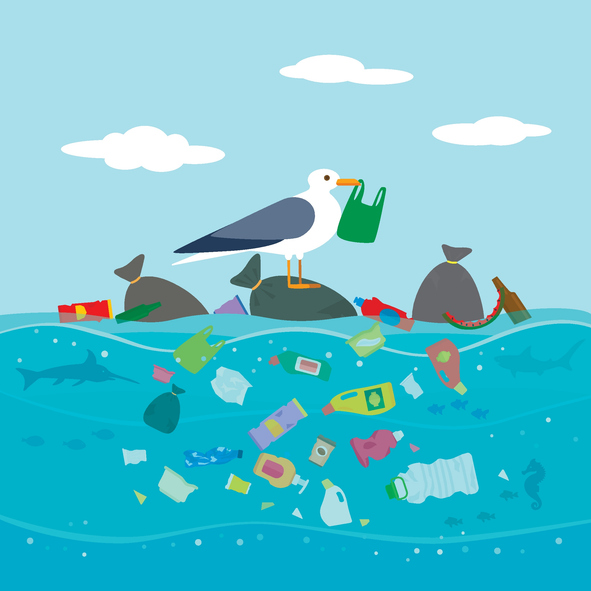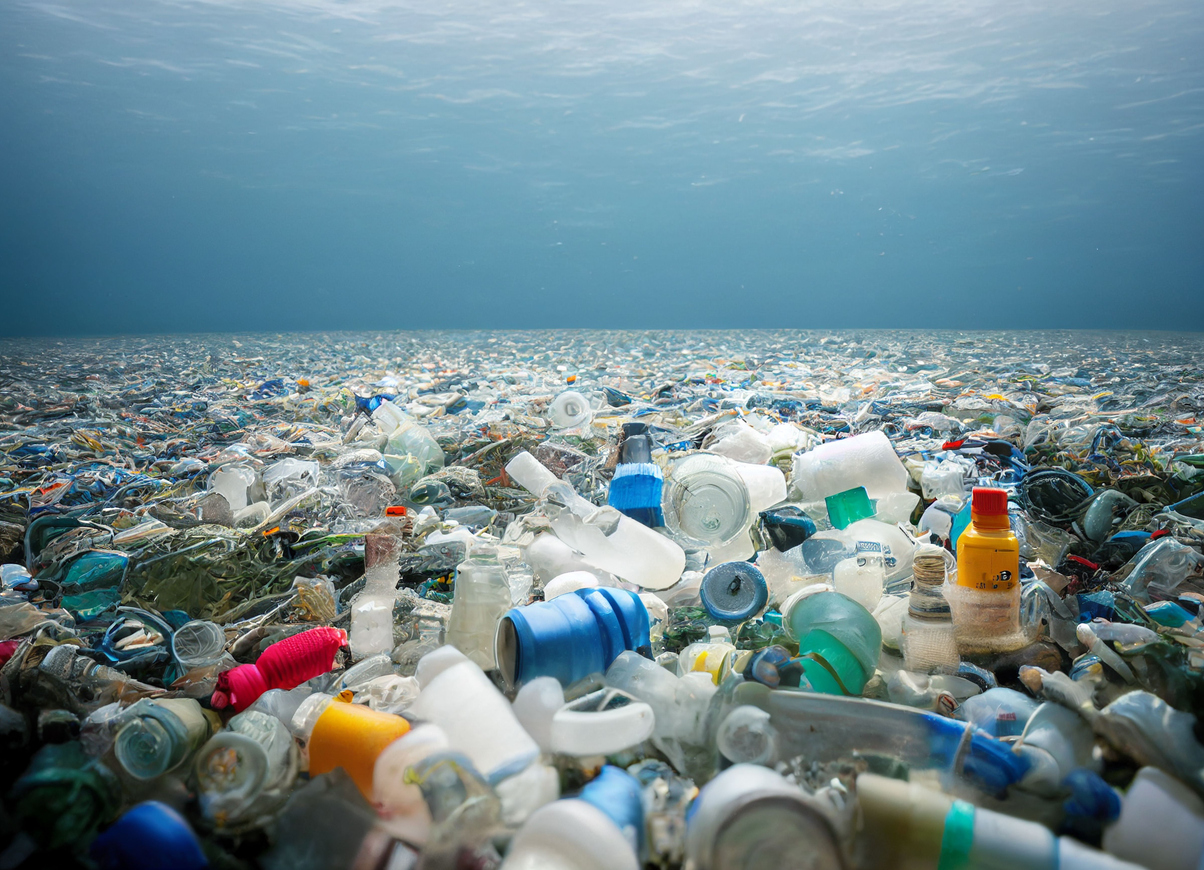Introduction
The development of plastic in the 20th century was nothing short of a revolution. It was cheap, lightweight, durable, and easy to manufacture. Plastic technology’s evolution has enabled it to infiltrate every field of life, from chairs to space shuttle parts.
However, plastics have a problem. Synthetic plastics, in particular, decompose at an alarmingly slow rate. Over several decades, this led to the accumulation of used plastic products in almost every environment. Today, plastic pollution has become a menace, making nature uglier and more dangerous due to its toxicity.
What is Marine Plastic Pollution?
Marine plastic pollution is the accumulation of plastic in the world’s oceans, negatively impacting animals, plants, and humans. Common items classified as plastic waste include cigarette butts, packaging, plastic bottles, and bottle caps. When items made of plastic end up in nature as waste, they contribute to plastic pollution.

Sources of Marine Plastic Pollution
Most plastic pollution in the ocean starts from the land through various pathways. An estimated 80% of the plastic waste in the ocean comes from land-based activities and the remaining 20% from water-based activities.
Land-based activities include plastic from waste management systems, storms, garbage dumps, and rainwater that collect in water bodies and flow out into the ocean. Water-based activities involve the use of plastic in the sea, such as fishing gear, plastic packaging, and other waste from ships and ports.
If we classify the waste generated by different continents, we learn that Asia produces 80% of marine plastic pollution. The following graphic helps us understand the role of different continents in global marine plastic pollution. You can click on the “Maps” and the “Table” tabs to further refine the data.
Effects of Plastic Pollution
Plastic waste is harmful to the environment. It affects it at the macro level and the micro level. We produce almost 400 million metric tons of plastic each year. Unlike other types of waste, plastic takes up to 400 years to decompose. Plastic waste produced in the early 20th century still exists today, while we continue to generate billions of tons of it each decade. We have had more plastic production in the last decade than in the previous ten decades combined.
An estimated 13 million metric tons of plastic enter the ocean every year. That is approximately 36,000 metric tons per day, equivalent to 3 truckloads every 2 minutes. Its uninhibited dumping into the ocean has formed garbage patches (e.g. Great Pacific garbage patch) across the oceans. Let us look at how plastic pollution impacts oceans in different ways.
Harm to marine life
Plastic debris affects an estimated 800 species worldwide, of all sizes.
Let’s start with corals. Plastic encourages pathogen growth in the ocean. As per research from 2018, 89% of corals that came in contact with plastic waste contracted diseases, compared to 4% when there was no contact. The research estimated that 11 billion plastic items were entangled in coral reefs across the Asia-Pacific in January 2018. The number of items was projected to reach 16 billion by 2025.
When it comes to sea turtles, almost half of them have ingested plastic. By mistaking plastic for food, the turtles are deceived into thinking they are full and end up dying from starvation.

Tiny creatures, such as sea horses and small fishes, ingest microplastics that travel up the food chain damaging others as well as themselves.
For instance, dolphins, although more intelligent than other creatures, end up ingesting plastic through the food chain. Microplastics are embedded in their fats and lungs.
Plastic litter is also responsible for killing up to a million seabirds every year. Similar to turtles, seabirds also die from starvation as the ingested plastic occupies space in their stomachs and gives them the illusion of being full when they’re not. Dead seabirds are found with stomachs full of plastic materials.

Harm to humans
Marine plastic pollution also affects human health as microplastics move up the food web. Plastic production involves the use of toxic chemicals that are carcinogenic and can impact the endocrine and reproductive systems. They also cause neurological and immune system disorders in humans and animals.
Researchers recently discovered the presence of microplastics in placentas. Further research is underway to determine the extent of this issue.
Indirectly, plastic pollution also affects human livelihoods by negatively impacting aquaculture, tourism, and fisheries.
Harm to the environment
Marine plastic pollution leads to the destruction of the environment in several ways. To begin with, plastic items are sourced from fossil fuels, which are responsible for issues such as climate change and global warming.
Their uninhibited dumping in terrestrial ecosystems can affect the delicate balance that these ecosystems usually maintain. In landfills, toxins from plastic waste can seep into groundwater systems, contaminating water sources.
The incineration of plastic waste also releases carbon dioxide and methane, which contribute to climate change.
Solutions to Marine Plastic Pollution
While plastic pollution seems to be getting out of hand with time, there are still many ways that we can make a difference. Our small steps, combined with government cleanup projects, can reverse plastic pollution sooner than anticipated. Let us consider small steps that individuals can take to reduce plastic pollution.
Reduce marine plastic pollution from land
Most marine pollution is caused by the waste that is discharged from coastlines and rivers. We need to curb plastic use and land dumping to reduce plastic waste in the sea. This can be achieved through the following measures.
-
Avoid single-use plastics such as straws, cutlery, bags, etc.
-
Use of refillable water bottles instead of plastic
-
Encourage bulk buying to reduce the amount of plastic packaging
-
Prefer recyclable plastics over disposable plastic
-
Carry cloth bags instead of plastic bags
-
Reuse plastic packaging where possible
-
Spread the word for community-level engagement and action such as coast and river cleanup projects
-
Choose juice/milk products that have recyclable packaging
Reduce marine plastic pollution at sea
Only a portion of the plastic waste generated on land enters the sea but almost all of the plastic waste generated at sea ends up in the oceans. It is therefore just as important to control plastic waste generation and disposal at sea as on land. This can be done in the following ways.
-
Implementation of plastic pollution laws to prevent disposal
-
Improved garbage reception infrastructure at ports for plastic and other trash
-
Use of Shipboard incinerators that are approved for plastic incineration
-
Bulk purchase of items such as detergents, foodgrains, and spices to reduce the amount of plastic generated onboard
-
Use of natural fiber bags instead of plastic where possible
-
Regular condition monitoring of anti-fouling paints to prevent the release of microplastics into the ocean
Summary
Our oceans and the marine organisms that live in them are succumbing to poisonous plastic. We are at a critical juncture. Scientists predict that unless effective action is taken, the weight of plastics in the ocean will exceed the weight of all fishes by 2050. It is therefore imperative that urgent and effective action is taken to address plastic pollution.
The above suggestions can help us closer to the goal but without a sustainable replacement for plastic, the problem is unlikely to go away completely.
But not all is grim. With every year, the awareness about the harms of plastic usage is growing. Both the public and the government are welcoming a zero waste philosophy and coming up with innovative solutions to mitigate the ocean plastic pollution problem.


Leave a Reply